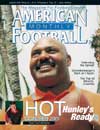AMERICAN FOOTBALL MONTHLY THE #1 RESOURCE FOR FOOTBALL COACHES
Article CategoriesAFM Magazine
|
Cover Your BasesA look at Base Coverage 2by: Mike Silecchia Head Football Coach, Lebanon Valley College of PA © More from this issue When coaching cover two to your athletes it is essential that they know that their first responsibility is to defend the pass. Undisciplined safeties and corners spell one thing for the offense a big play. The secondary must be able to distinguish between what is an aggressive play and what is an over aggressive and undisciplined play. Most secondary breakdowns occur when there is an over-reaction to an initial read, which occurs at the snap of the ball. A simple illustration of this is a safety in cover two, coming out of his back pedal, and reacting to the run on play-action pass. If the safety can maintain his discipline and proceed through his proper progression of reads before diagnosing the play, he can be assured of being in position to make a play.
Keys As the offensive players take their initial steps, there....The full article can only be seen by subscribers.
|
|
|||||||
| HOME |
MAGAZINE |
SUBSCRIBE | ONLINE COLUMNISTS | COACHING VIDEOS |
Copyright 2025, AmericanFootballMonthly.com
All Rights Reserved





